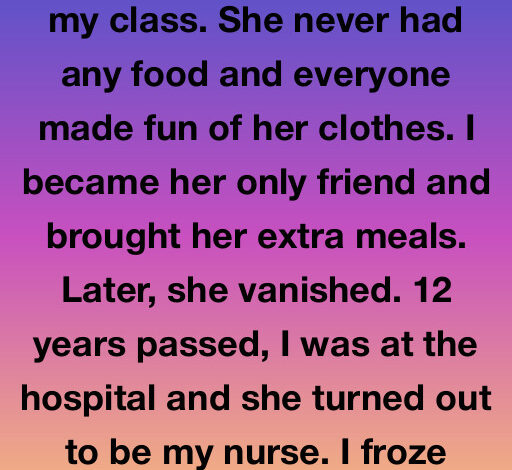
In fifth grade, Amy was the kid everyone overlooked—or worse, mocked. Her sleeves were too short, her shoes patched with tape, and her lunchbox was always empty. The first time I noticed her miming the act of chewing while the rest of us ate, my stomach twisted. The next day I packed an extra cheese sandwich, slipped it across the table, and pretended I wasn’t hungry either. She refused at first, but I insisted. That small act became our unspoken agreement. I’d bring something to share—half a PB&J, an apple, whatever I could sneak past my mom—and Amy would pretend not to need it until she finally gave in.
Kids snickered when they saw me sit with her. I didn’t care. Amy was quiet until she wasn’t. Once you earned her trust, her humor surfaced—sharp, surprising, and clever. She could sketch anything with a pencil. One afternoon, she drew us on the playground swings, my hair flying, her head tipped back mid-laugh. I carried that sketch in my notebook like treasure.
Then one Monday, she was simply gone. Her desk sat empty. When I asked, the teacher only shrugged. I wrote notes and left them in the office. Weeks later, an envelope appeared, stuffed with my letters. Inside was a single line in her handwriting: “Thank you for seeing me when no one else did.” That was all. Then silence. She vanished, swallowed by the kind of childhood mystery you never really solve.
Twelve years later, I woke up groggy in a hospital bed, IV tugging at my arm. A nurse entered, hair in a tight bun, badge swinging. She smiled gently and said, “You’ll be okay. You helped me once. I never forgot.”
It took me a moment, but then it hit me. “Amy?”
Her eyes brightened. “Yeah. It’s me.”
She pulled up a chair, and just like that, the years melted away. She told me her family had moved overnight when we were kids, chasing jobs, crammed into motels. High school was a blur of part-time work, scholarship forms, and one kind nurse who paid her exam fees when money ran dry. “Kindness circles back,” she said softly, checking my vitals. I felt the truth of it sink into my bones.
We caught up while I healed. She remembered every sandwich. I reminded her she once saved me during a group project by drawing a perfect poster in pencil. Before I left, she handed me a folded paper—my old fifth-grade list of “things Amy is good at.” The childish block letters read: good at drawing, brave, fast on swings, kind. She had kept it all these years. “It told me I mattered,” she said.
Coffee followed discharge. Coffee became dinners, then long walks, then movie nights on my couch. One evening, my heart beat faster than my courage. I blurted, “You were my favorite person back then. I think you still are.”
Amy squeezed my hand. “You were the first person who ever really saw me.”
Life wove us back together. She worked nights at the hospital, I returned to my job, and weekends belonged to us. Then her mother was diagnosed with late-stage pancreatic cancer. Amy moved in to care for her. I carried groceries, changed lightbulbs, and sat with them on the porch when evenings were cooler and grief felt less sharp. Watching Amy pour herself into caregiving cracked me open. “I got love when I needed it most,” she said once, tucking a blanket around her mother’s knees. “Now I’m giving it back.”
Her mom passed peacefully. At the funeral, Amy read a poem she had written years earlier about invisible hands holding you steady. There wasn’t a dry eye in the room.
Soon after, she asked me to move in. We found a small apartment with creaky floors and wide windows. On Sundays we cooked while old records spun in the background. On Thursdays we bickered over true crime documentaries and guessed the wrong killer every time.
While cleaning one afternoon, Amy found an old notebook of sketches. “I always had to choose survival over art,” she whispered. “Not anymore,” I told her, and signed her up—without asking—for a local art show. She cursed at me, then nervously agreed. Her drawing of her mom’s hands holding a paper lunch bag won first prize. A gallery asked to feature her work. Soon commissions arrived, then an offer to teach art therapy to children. Amy bloomed, and she made me bloom with her.
I proposed on the park swing she once drew us sitting on as kids. She said yes, tears streaming, graphite smudges still on her fingers. At the wedding, I told our story—the sandwiches, the empty desk, the nurse who walked into my hospital room and never walked out of my life. “You saved me,” I said into the microphone. She leaned close and whispered, “You saved me first.”
Today we run a little art café on a corner washed in morning sunlight. Amy paints in the back while I work the espresso machine. A sign by the door reads: If you’re hungry, don’t be shy. We’ve been there. Every month we donate to school lunch programs and art supplies. Sometimes kids wander in alone, small and uncertain, jackets too thin for the season. Amy spots them first every time. She brings cocoa, sits quietly with them, and reminds them—without ever saying it outright—that they matter.
Life is rarely fair. It takes without asking and leaves without warning. But the small kindness you offer doesn’t vanish. It lingers, tucked away in a memory, scribbled on a note, or folded in a sketchbook—waiting for its chance to return. Sometimes it comes back as a nurse in your darkest hour. Sometimes as a partner, a new life, a second chance you didn’t even know you were waiting for.
Be kind, even when no one’s watching. Especially then. It matters. It always has.





